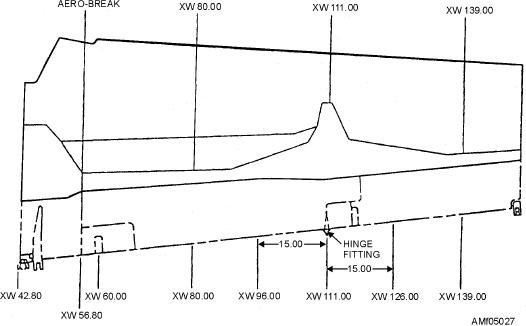
lications, materials, tools and equipment, and repair
Class V
Damage is single skin damage, includ-
procedures.
ing full penetration, accompanied with
honeycomb core damage.
The repair facilities where the work is to be
performed will be clean and climate controlled if
Class VI
Damage to both skins, including full
possible. The relative humidity should be 25 percent to
penetration, accompanied with honey-
60 percent and temperatures stable at 65F to 75F. If
comb core damage.
repairs are to be made in an uncontrolled environment
Class VII
Damage is water trapped in honeycomb
(hangar/flight deck), patches and adhesives will be
area.
prepared in a controlled environment and sealed in an
airtight bag before being brought to the repair site.
REPAIR CRITERIA
Strength Restoration
Repair criteria differ in the same way that initial
design requirements for aircraft differ. Criteria for a
Full strength repairs are desirable and should be
repair can be less demanding if the repair is considered
made unless the cost is prohibitive or the facilities are
temporary. Temporary repairs are performed for such
inadequate. Less than full strength repairs are
requirements as a onetime flight to a repair facility or
sometimes allowed on secondary structures that are
one more mission under combat conditions. However,
lightly loaded, stiffness-critical structures designed for
most repairs are intended to be permanent, and, except
limited deflections rather than for carrying large loads
for special conditions, criteria are applied so that the
(doors), or structures designed to a minimum thickness
repair will remain acceptable for the life of the aircraft.
requirement for general resistance to handling damage
(fuselage skins). Repair manuals for specific aircraft
One of the major factors that influence the repair
frequently "zone" the structure to show the amount of
quality is the environment where the repairs are to
strength restoration needed or the kinds of standard
made. For example, the presence of moisture is critical
repairs that are acceptable. Repair zones help to
to bonded repairs. Epoxy resins can absorb 1.5 to 2
identify and classify damage by limiting repairs to the
times their weight in moisture, thereby reducing the
load-carrying requirements. Repair zone borders
ability of the resins to support the fibers. Dirt and dust
indicate changes in load-carrying requirements due to
can seriously affect bonded repairs. Oils, vapors, and
changes in the structure, skin thickness, ply drop-offs,
solvents prevent good adhesion in bonded surfaces and
location of supporting members (ribs and spars), ply
can lead to voids or delaminations. To perform quality
orientation, core density, size and type of materials.
repairs, personnel must have a knowledge of the
Damage in one zone may be repairable, where as the
composite system to be repaired, type of damage,
same type of damage in an adjacent zone may not be
damage limitations/ classifications, repair pub-
repairable. See figure 5-27.
Figure 5-27.--Repair zones.
5-22

